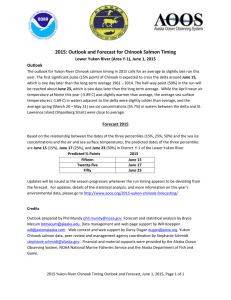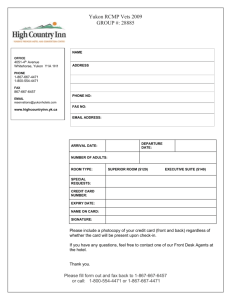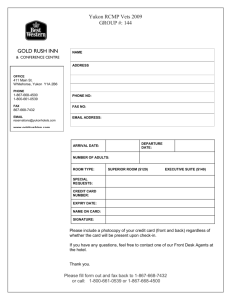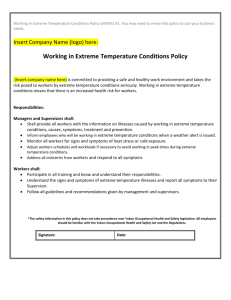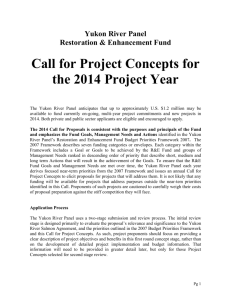UTILIZATION OF HABITATS
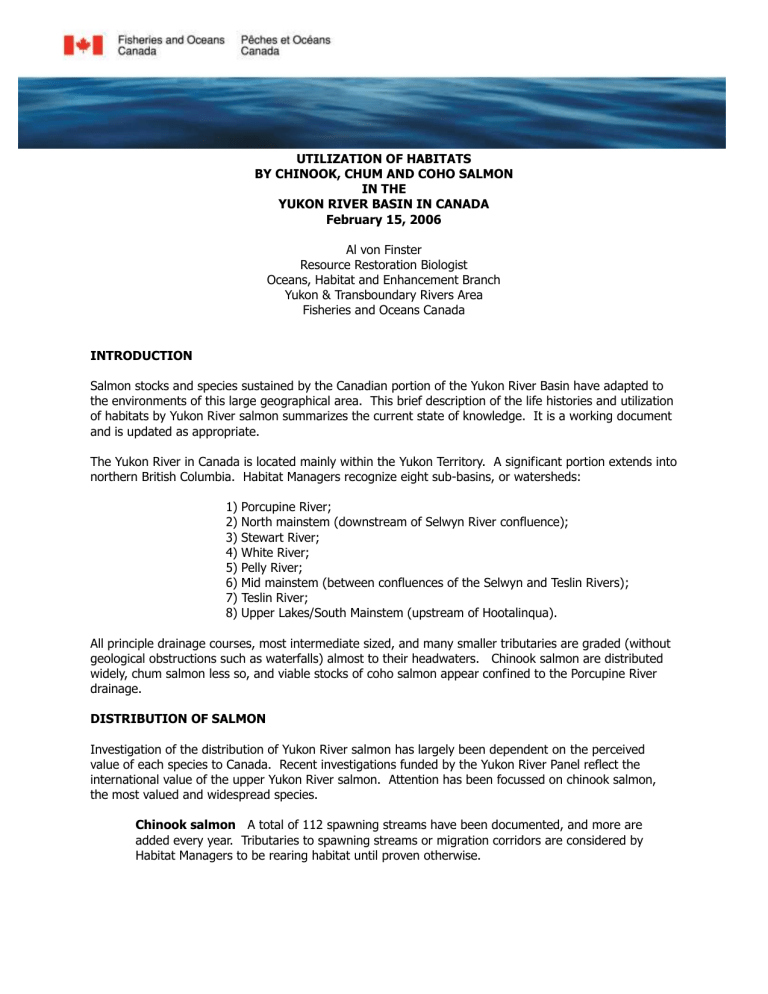
UTILIZATION OF HABITATS
BY CHINOOK, CHUM AND COHO SALMON
IN THE
YUKON RIVER BASIN IN CANADA
February 15, 2006
Al von Finster
Resource Restoration Biologist
Oceans, Habitat and Enhancement Branch
Yukon & Transboundary Rivers Area
Fisheries and Oceans Canada
INTRODUCTION
Salmon stocks and species sustained by the Canadian portion of the Yukon River Basin have adapted to the environments of this large geographical area. This brief description of the life histories and utilization of habitats by Yukon River salmon summarizes the current state of knowledge. It is a working document and is updated as appropriate.
The Yukon River in Canada is located mainly within the Yukon Territory. A significant portion extends into northern British Columbia. Habitat Managers recognize eight sub-basins, or watersheds:
1) Porcupine River;
2) North mainstem (downstream of Selwyn River confluence);
3) Stewart River;
4) White River;
5) Pelly River;
6) Mid mainstem (between confluences of the Selwyn and Teslin Rivers);
7) Teslin River;
8) Upper Lakes/South Mainstem (upstream of Hootalinqua).
All principle drainage courses, most intermediate sized, and many smaller tributaries are graded (without geological obstructions such as waterfalls) almost to their headwaters. Chinook salmon are distributed widely, chum salmon less so, and viable stocks of coho salmon appear confined to the Porcupine River drainage.
DISTRIBUTION OF SALMON
Investigation of the distribution of Yukon River salmon has largely been dependent on the perceived value of each species to Canada. Recent investigations funded by the Yukon River Panel reflect the international value of the upper Yukon River salmon. Attention has been focussed on chinook salmon, the most valued and widespread species.
Chinook salmon A total of 112 spawning streams have been documented, and more are added every year. Tributaries to spawning streams or migration corridors are considered by
Habitat Managers to be rearing habitat until proven otherwise.
Chum salmon The distribution of chum salmon spawning is poorly understood. There are a few major spawning nodes (e.g., Kluane and Minto/Selkirk areas), and a confusing array of records and reports of spawning in various rivers, streams and lakes.
Coho salmon Spawning populations are known only in the Porcupine River Watershed. Adult coho have been observed in the Fishing Branch of the Miner River.
LIFE HISTORIES OF SALMON
A great deal of effort has been expended toward the management of Yukon River salmon. A wide range of technical reports on salmon have been prepared by government, industry and environmental nongovernmental organizations. There are also a number of derivative summaries and map folios. As quality varies widely, all documents should be considered critically, particularly derivative reports and mapping products.
An account of the current knowledge of life histories follows:
Chinook salmon
Juveniles emerge between early May (von Finster 1996-1) and late June (von Finster
1996–2) between 35 and 38 mm fork length (Duncan et al. 2004). Emergent juveniles are usually found in still-water areas such as the advancing margins of rivers and other low velocity habitats.
Young-of-year (0+) juveniles may remain in spawning streams (de Graff 2004) for the first summer. Densities of fish may be high and rates of growth may be low in such streams
(von Finster 1989-3). An undetermined, but considerable and perhaps dominant, portion of the cohort migrate downstream and then ascend non-natal tributaries (Perry et al. 2003). These streams may be 200 km or more from spawning sites (Duncan et al. 2004). Entrance to nonnatal tributaries in the Whitehorse area commences in June (Moodie et al. 2000; Moodie 2000) and about a month later in the Dawson area (Duncan et al. 2004) at a fork lengths between 45 and 55 mm (Bradford et al. 2001).
The 0+ juveniles may migrate significant distances (>34 km) upstream in non-natal tributaries (Fisheries and Oceans Canada, unpublished information). In small, moderate gradient non-natal streams, the juveniles are most numerous in small pools (Bradford et al. 2001). In larger streams, the juveniles appear to use in-channel analogues of these pools (Lister et al.
1991). Juvenile Chinook salmon are seldom found in completely still water in non-natal rearing streams. At any given time, 0+ juveniles in upstream areas of a non-natal tributary tend to have greater average lengths than do those closer to the mouth (Moodie et al. 2001). High densities of 0+ juveniles may be found immediately downstream of partial or total obstructions such as beaver dams (von Finster, 1987). Young-of-the-year are absent or are present in low densities in waters with high turbidity, or where periods of high turbidity are frequent. Densities tend to be low in clear water streams after summer high water/high turbidity events (Hunka et al. 1988).
Aquatic predators are include northern pike, lake trout, burbot and inconnu. Juvenile chinook are almost absent in streams after families of mergansers have passed through, inferring significant predation by these birds. Kingfishers, gulls, loons and other birds also feed on the juveniles during the open water period.
Successful over-wintering of 0+ juveniles has been documented only in streams and smaller rivers (Bradford et al. 2001; Harder 1989), and in ground water fed off-channel habitats
(von Finster 2001). Over-wintering in small streams appears to be related to local ice formation and to groundwater sources (Bradford et al. 2001). Areas with deposits of glacio-fluvial or derivative material have high potential to store and release groundwater during winter (USGS
2006). Over-wintering has not been documented in lakes. No juvenile chinook salmon were identified in the stomachs of 219 predatory fish (burbot, lake trout and inconnu) captured in Lake
Laberge during the winters of 1985 through 1989, inferring that juvenile chinook were not present ( von Finster 1991). Overwintering uveniles were abundant in a ground water channel until mink appeared and were thereafter absent (von Finster, 2005).
Over-wintering juveniles grow rapidly in spring; average body mass increases by more than 50% prior to out-migration from over-wintering sites (Bradford et al. 2001). Movement of one year old (1+) juveniles from small streams appears to be related to annual thermal regimes, and to be delayed if the spring is cool or late (Moodie 2000). Few 1+ juveniles are captured in the Yukon River in Canada after July 15 of any given year, and then usually only in spawning streams. These may become residuals and not migrate to sea.
The downstream migration of 1+ juvenile chinook through Canada is poorly documented, but appears to closely follow the out-migration from non-natal streams (Duncan et al. 2004).
Adult Yukon River chinook salmon return to spawn in lake outlets, major rivers, small streams or in waters with intermediate characteristics (von Finster 1989-3). Spawning dunes may be well developed in buffered systems, such as those downstream from lakes. Substrate requirements, redd structure, and spawning behaviour have not been specifically studied in the
Yukon River drainage. Groundwater discharge areas are not preferred spawning locations.
Chum salmon
The two main types of chum in the Yukon River drainage are referred to as “summer” and “fall” chum based on the timing of entry to the river. Fall chum migrate furthest upstream.
Few summer chum reaching the Canadian border. Almost all chum salmon in the Canadian portion of the Yukon River drainage are fall chum.
Emergent juveniles were observed at a spawning location in the Kluane River from mid-
April to mid-June (von Finster 1989-1). Out-migrating juvenile chum were captured in a Rotary
Screw Trap at Dawson in 2002 and 2003. In both years peak captures were in June and declined quickly into July (Duncan, 2004).
Spawning occurs in the autumn and may be highly concentrated. Fall chum salmon spawn in groundwater discharge areas, where water of sufficient quality and quantity to sustain incubation is released into channels at a fairly constant flow rate and temperature of 3-5 degrees
C. (von Finster 1996-3). In some systems, seasonally off-channel habitats are preferred
(Laberge Environmental Services 2000), and in others the main channel is utilized (Steigenberger et al. 1975). Shore spawning has been observed documented in Kluane Lake. Recently, summer chum have appeared to be colonizing Canadian waters, with reports of spawning in Mickey Creek
(tributary to the Fortymile R.) and the Klondike River (Godfrey 1995) .
Coho salmon
Coho follow the chum salmon into the Porcupine River, migrating upstream after the ice has formed. Low numbers of returning adult coho have been observed at the Fishing Branch weir near the end of the chum run in October. Adult coho are occasionally caught in the chum salmon fisheries near Dawson City. Low numbers of adults are also captured in the chum salmon fisheries near Dawson City. Little is known of the life history of this stock.
Literature Cited:
Bradford, M. J., J. A. Grout, S. Moodie. 2001 Ecology of juvenile chinook salmon in a small non-natal stream of the Yukon River drainage and the role of ice conditions on their distribution and survival.
Canadian Journal of Zoology, vol. 79, p 2043-2054 de Graff, N. 2004. Michie Creek Chinook Salmon Field Investigations 2003. In: Geis Too’e’: King Salmon
River - m’Clintock River Watershed Management Planning and Michie Creek Field Investigations 2003.
Prepared for the Yukon River Panel Restoration and Enhancement Fund: CRE-50-03. 106 p & appendices.
Duncan, J. and M. Bradford. Jan 2004. Yukon River Juvenile Chinook and Chum Salmon Out-Migration
Timing and Sampling Characteristics as Determined Using a Rotary Screw Trap, 2003. Yukon River Panel
CRE-01-03. 35 p. & Appendices
Godfrey, J. September 21, 1995. Chum Salmon on Lower Fortymile. Memorandum. U.S. Department of the Interior Bureau of Land Management. 1 p. & attachments.
Harder, P.A. and Associates. Dec 1989. Impact Assessment of Fish Resources in Vangorda Creek.
Curragh Resources Inc. 80 p. & Appendices.
Hunka R. and D. Schuyler. 1988. Abundance, Distribution, Habitat Utilization and Habitat Preference of
Juvenile Chinook Salmon (
Oncoryhynchus Tshawytscha
) in three Study Areas of the Upper Yukon River
Basin, 1988 Canada-Yukon Economic Development Agreement.). 73 p + appendices.
Leberge Environmental Services. 2000. Characterisation of chum spawning sloughs located near the mouth of Big Creek. Prepared for Minto Explorations Ltd. 18 p + Addendices
Lister, D. B. and R. J. Beniston. 1991. McIntyre Creek Power Plant No. 3 Assessment of Impact on
Salmonid Fish Habitat and Proposal for Compensatory Habitat Prepared for Yukon Electrical Company
Limited.
Moodie, S., J.A. Grout, and A. von Finster. 2000. Juvenile Chinook Salmon
(Oncorhychus tshawytscha)
utilization of Croucher Creek, a small Non-natal Tributary of the Upper Yukon River during 1993. Canadian
Manuscript Report of Fisheries and Aquatic Sciences 2531. 65p
Moodie, S. March 2000. Croucher Creek 1999: Juvenile Chinook Salmon (
Overwintering and Migration Study in a Small Non-natal Tributary of the Upper Yukon River. Yukon
Conservation Society/Kwanlin Dun First Nation. 48p
Perry, R.W., M.J. Bradford, and J.A. Grout. 2003. Effects of disturbance on contribution of energy sources to growth of juvenile Chinook salmon
(Oncorhynchus tshawytscha)
Aquat. Sci. 60: pp 390 - 400 (2003). NRC Canada.
Oncorhynchus tshawytscha
)
in boreal streams. Can. J.
Steigenberger, L.W., M.S. Elson, and R.T. DeLury. 1975. Northern Yukon Fisheries Studies, 1971 – 74.
Environment Canada, Northern Operations Branch, Pacific Region. PAC/T – 75 – 19.
USGS Unconsolidated and Semi-consolidated Sand and Gravel Aquifers in: http://capp.water.usgs.gov/aquiferBasics/uncon.html von Finster, A. September 1987 Beaver Dam Investigation on Flat Creek, a tributary of the Takhini River.
Habitat, District 10. 8p. von Finster, A. June 15, 1989. Chum fry emergence: Mile 118 Alaska hwy slough on the Kluane River.
DFO – Whitehorse. 1 p. von Finster, A. Sept 5, 1989. Bearfeed Creek, tributary to Little Salmon. Memorandum to file. Habitat
Management Unit, FR, NWBC & Yukon Division 3 p. von Finster, A. 1989. Spawning preferences in Yukon Salmon. In: Leith, D.M. 1990. . Proceedings of the First Annual Conference on Science: Yukon Water March 19 – 21, 1989. Yukon Science Institute,
Whitehorse Yukon. 106 p. + Appendices. von Finster, A. Oct 14, 1991. Overwintering of Juvenile Chinook Salmon in the YukoN River Drainage
Basin. Memo to file. 2 p. von Finster, A. May 19, 1996 - 1. Chinook spawning: upstream of Robert Campbell Bridge Memorandum to file. Habitat and Enhancement Branch, Yukon and Transboundary Rivers Division, Dept. Fisheries and
Oceans. 2p. von Finster, A. July 2, 1996 - 2. Successful incubation and emergence of Chinook salmon.
Memorandum to Stream Files Wolf Creek. Habitat and Enhancement Branch, Yukon and Transboundary
Rivers Division, Dept. Fisheries and Oceans. 1 p. von Finster, A. November 1996. Chum spawning habitat: Water Sampling: 1118 Slough, Kluane River.
Habitat Management, Fisheries and Oceans Canada. 2 p & attachment. von Finster, A. May 31, 2001 Spring investigations: North Klondike; Klondike Flat Creek and Yukon River near Dawson – May 26 & 27, 2001. DFO HEB. 6p von Finster, A. March 12, 2005. Sampling, Viceroy (North Klondike) and Germaine Creek (Klondike) ground water channels. Memo to stream file- Klondike River, North Klondike River, File CRE-87-05. OHEB
Y&TBR, Fisheries and Oceans Canada. 3p
